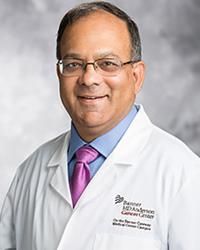SIERRA Trial: Background on the Iomab-B Combination in Relapsed/Refractory AML
In an interview with <em>Targeted Oncology</em>, Rajneesh Nath, MD, discussed the background and rationale for the phase III SIERRA trial. He also explained what this research means for the treatment landscape of acute myeloid leukemia.
Rajneesh Nath, MDS

Rajneesh Nath, MD
Patients with relapsed or refractory acute myeloid leukemia (AML) have limited approved treatment options available to them. The fact that these patients are typically over the age of 55 also means that they often cannot be included in clinical trials that may help get them to remission. To address this unmet need, investigators conducted the phase III SIERRA trial.
The study randomized patients with relapsed/refractory AML 1:1 to receive apamistamab (Iomab-B, day-12), an anti-CD45 monoclonal antibody, followed by fludarabine/total body irradiation [FLU/TBI] and allogeneic hematopoietic cell transplantation (HCT) or conventional care (CC), defined as the investigator’s choice of salvage chemotherapy.
The preliminary results, which will be presented at the 2020 Transplantation & Cellular Therapy (TCT) Meeting, show that 100% of the patients who received the Iomab-B combination were able to undergo HCT and were successfully engrafted. Only 18% of patients in the CC arm were able to undergo HCT.
In an interview withTargeted Oncology, Rajneesh Nath, MD, a medical oncologist at the Banner MD Anderson Cancer Center in Gilbert, AZ, discussed the background and rationale for the phase III SIERRA trial (NCT02665065). He also explained what this research means for the treatment landscape of AML.
TARGETED ONCLOGY: Can you provide background on the SIERRA trial?
Nath: Patients with AML who have never gone into remission (primary refractory) or those who have gone into remission with standard chemotherapy but have subsequently relapsed have a very poor prognosis. The only cure for these patients is an allogeneic HCT. This is especially true for patients older than age 55, which is most of the patients with AML. The outcomes for HCT are the best when the transplant is performed in patients after they have achieved a complete remission. Traditionally patients with relapsed or refractory AML first undergo salvage chemotherapy in an attempt to put them in complete remission (CR) and once they achieve CR, they undergo HCT. Patients who are older than age 55 or those who do not achieve a CR are frequently not offered this curative HCT. The Sierra trial targets the older refractory/relapsed patients with AML who will otherwise be not offered a curative HCT.
TARGETED ONCOLOGY:What was the rationale for this study?
Nath: CD45 is an antigen that is present on all hematologic cells and includes both the acute myeloid leukemia cells and hematopoietic stem cells. In this study upon Apamistamab (Iomab-B) is used to target CD45 antigen on both leukemic stems and hematopoietic stem cells to combine both salvage chemotherapy and allogenic HCT in a single procedure. The patients undergo allogeneic HCT without prior salvage therapy. The purpose of the study is to evaluate if the outcomes of older patients with relapsed/refractory AML who undergo allogeneic HCT using Apamistamab are better than those were randomized to conventional care arm.
TARGETED ONCOLOGY: What are the implications of the preliminary data that are being presented at TCT 2020?
Nath: [We first set out to determine if the combination was safe]. The regional study from Seattle showed that this treatment is safe when it is done in multiple centers around the country. The data showed that the treatment was safe enough that we can continue accruing patients. We have already accrued more than the original 75 patients.
Secondly, because these are relapsed/refractory patients and nothing is putting them into remission, the way the study was designed was that a cross-over was possible if the patients got standard-of-care chemotherapy and did not go into remission. They could crossover to the Iomab-B followed by FLU/TBI and HCT arm. In the study, a significant portion of patients were able to crossover and a lot of those patients did achieve remission.
What is being shown in this study and has been shown in the past is that when you have to wait for 2 to 3 weeks to attempt to put patients into remission and you look at their bone marrow, you'll see that their level of leukemia increases as we are waiting. It's still safe to use these regimens and proceed; some patients can achieve a remission, even some of those patients who were unable to achieve a remission with any other treatment.
TARGETED ONCOLOGY: What unmet need can this treatment serve in AML?
Nath: This treatment is targeting a population of patients over the age of 55 years. Normally, the older you are, the less your ability to tolerate a transplant. Also, patients who are older and not going into remission would be excluded from most of the transplant trials. The irony of the situation is that AML is, in fact, a disease of the elderly. The median age of patients with AML is about 68 years. Therefore, clinical trials are excluding the bulk of the patients [who] would benefit from having stem cell transplantation.
TARGETED ONCOLOGY: What are the next steps with this research?
Nath: After we have treated enough patients, we can determine if the duration of remission is extended, giving these patients a meaningful remission and possibly a cure. The data are still pending.
Reference:
Gyurkocza B, Nath R, Stiff PJ, et al. Targeted conditioning with anti-cd45 iodine (131i) apamistamab [iomab-b] leads to high rates of allogeneic transplantation and successful engraftment in older patients with active, relapsed or refractory (rel/ref) aml after failure of chemotherapy and targeted agents: preliminary midpoint results from the prospective, randomized phase 3 Sierra trial. https://bit.ly/326ptxm. Accessed February 18, 2020.